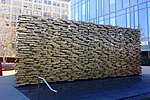Higgins Building
1900s architecture in the United States1909 establishments in CaliforniaBeaux-Arts architecture in CaliforniaBuildings and structures in Downtown Los AngelesEmporis template using building ID ... and 3 more
Los Angeles Historic-Cultural MonumentsOffice buildings completed in 1909Office buildings in Los Angeles

The Higgins Building is a proto-Modernist concrete framed building rendered in the Beaux-Arts style located in downtown Los Angeles, California. Completed in 1910 by owner Thomas Higgins, an Irish American, the 10-story building was originally used for office space. The Engineers and Architects were Albert C. Martin, Sr. and A.L. Haley. It has been designated as a historical monument by the City as Historic-Cultural Monument #873. Although designed as an eight story high building, it was decided during the construction stage to add two additional floors in order to hold the reputation as being the highest building in the city centre.
Excerpt from the Wikipedia article Higgins Building (License: CC BY-SA 3.0, Authors, Images).Higgins Building
West 2nd Street, Los Angeles Downtown
Geographical coordinates (GPS) Address External links Nearby Places Show on map
Geographical coordinates (GPS)
| Latitude | Longitude |
|---|---|
| N 34.0511 ° | E -118.2449 ° |
Address
West 2nd Street 108
90012 Los Angeles, Downtown
California, United States
Open on Google Maps






